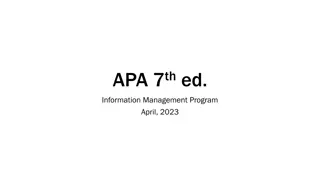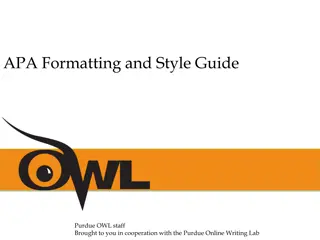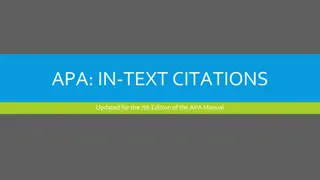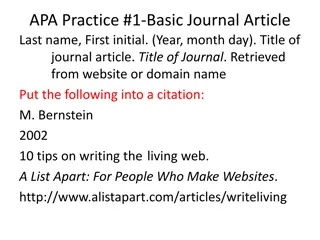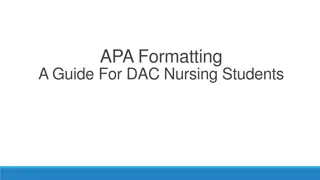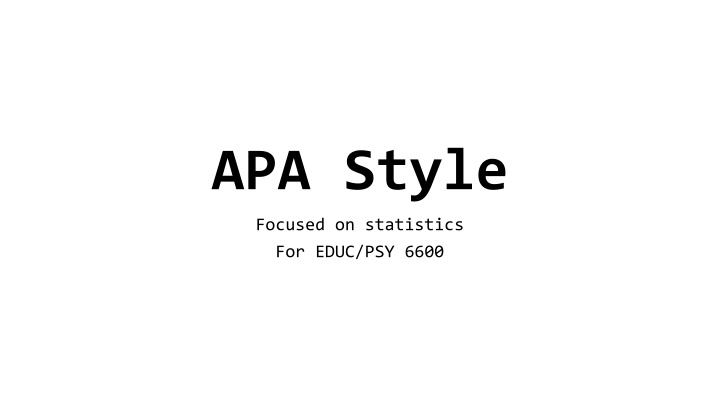
APA Style Guidelines for Statistics in Educational and Psychological Research
Learn the essential APA style guidelines for presenting statistics in educational and psychological research, including formatting numbers, abbreviations, data analysis, result presentation, and creating tables. Ensure your academic papers and presentations adhere to the APA 7th edition standards for clarity and consistency.
Download Presentation

Please find below an Image/Link to download the presentation.
The content on the website is provided AS IS for your information and personal use only. It may not be sold, licensed, or shared on other websites without obtaining consent from the author. If you encounter any issues during the download, it is possible that the publisher has removed the file from their server.
You are allowed to download the files provided on this website for personal or commercial use, subject to the condition that they are used lawfully. All files are the property of their respective owners.
The content on the website is provided AS IS for your information and personal use only. It may not be sold, licensed, or shared on other websites without obtaining consent from the author.
E N D
Presentation Transcript
APA Style Focused on statistics For EDUC/PSY 6600
American Psychological Association (APA) Format Now using the 7th edition Used for: Theses Dissertations Paper/Journal Articles Presentations/Posters Homework for this course (most importantly!)
APA Format: numbers (pg 178-179) If number < 10 then write it out ( four instead of 4) Use zero 0 before decimal ( 0.25 instead of .25) Do not report any decimal places if you are reporting something that can only be a whole number (n = 5 not n = 5.0) Report exact p-values (unless less than .001 then report p < .001) No leading zero on p-values (p = .006, not p = 0.006)
APA format: analysis Referencing analysis method? Common: no Rare or new: yes Descriptive statistics: Abbreviations (spell out if not followed by stats) oOKAY: scores were higher for males (M = 5, SD = 6) oNOT: the M was higher for males Inferential statistics : Distributions, df, N (sometimes), tests statistics, p-values, effect size, t(32) = 4.75, p < 0.05, Cohen s d = 0.87
APA format: results Results may presented as: text, tables, or figures Rules of thumb: (pg 181) TEXT if < 4 numbers/statistics TABLE if 4 to 20 numbers/statistics FIGURE if 20+ numbers/statistics Pick the method that best communicates the results/message Symbols & abbreviations N vs. n Italicized See pages 170-178 of APA publication manual (7th ed)
APA format: Tables Must be able to stand on its own Number tables sequentially in text (Table 1, Table 2, ect.) Only 3-4 tables per manuscript (different for theses/disertations) Results Table types Descriptive statistics for N or n (or both) Inferential statistics for ANOVA, MLR, ect. Both descriptive AND inferential info in the same table -> USE HEADINGS to organize Data not applicable: leave blank Data not obtained/not computable: use a dash -
APA format: Tables Title (top) Descriptive First Letter of Each Word in CAPS No period at the end Appears on row below Table 1 Title may be italicized Caption and Notes (bottom) General Note Explains/qualifies info in table, symbols, abbreviations No explanation for basic stats (M, SD, no. N, n) Specific Note Begin on a new line, flush left Define superscripts a, b, c Probability note Begin on a new line, flush left * p < 0.05, ** p < 0.01, *** p < 0.001, **** p < 0.0001
APA format: Figures Includes: charts, graphs, photos, drawings, images, etc. Must stand on its own: simple BUT illustrates a point Number tables sequentially in text (Figure1, Figure2, etc.) Caption Appears belowfigure, immediately after Figure 1 on same row NOT a title, NOT capitalized Brief, but descriptive explanation of figure After 1st sentence, add clarifying info Legend Same font style and size as in figure


